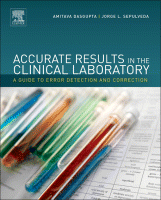Browse content
Table of contents
Actions for selected chapters
- Full text access
- Book chapterNo access
Chapter 1 - Variation, Errors, and Quality in the Clinical Laboratory
Jorge Sepulveda
Pages 1-8 - Book chapterNo access
Chapter 2 - Effect of Age, Gender, Diet, Exercise, and Ethnicity on Laboratory Test Results
Octavia M. Peck Palmer
Pages 9-17 - Book chapterNo access
Chapter 3 - Effect of Patient Preparation, Specimen Collection, Anticoagulants, and Preservatives on Laboratory Test Results
Leland Baskin, Valerian Dias, ... Christopher Naugler
Pages 19-34 - Book chapterNo access
Chapter 4 - Sample Processing and Specimen Misidentification Issues
Alison Woodworth and Amy L. Pyle
Pages 35-51 - Book chapterNo access
Chapter 5 - Hemolysis, Lipemia, and High Bilirubin: Effect on Laboratory Tests
Steven C. Kazmierczak
Pages 53-62 - Book chapterNo access
Chapter 6 - Immunoassay Design and Mechanisms of Interferences
Pradip Datta
Pages 63-73 - Book chapterNo access
Chapter 7 - Effect of Herbal Remedies on Clinical Laboratory Tests
Amitava Dasgupta
Pages 75-92 - Book chapterNo access
Chapter 8 - Challenges in Routine Clinical Chemistry Testing: Analysis of Small Molecules
Jorge Sepulveda
Pages 93-129 - Book chapterNo access
Chapter 9 - Challenges in Routine Clinical Chemistry Analysis: Proteins and Enzymes
Jorge Sepulveda
Pages 131-148 - Book chapterNo access
Chapter 10 - Sources of Inaccuracy in Biochemical Genetics Testing
Michael J. Bennett
Pages 149-154 - Book chapterNo access
Chapter 11 - Challenges in Endocrinology Testing
Lindsay A.L. Bazydlo, Neil S. Harris and William E. Winter
Pages 155-175 - Book chapterNo access
Chapter 12 - Pitfalls in Tumor Markers Testing
Alyaa Al-Ibraheemi, Amitava Dasgupta and Amer Wahed
Pages 177-193 - Book chapterNo access
Chapter 13 - Issues of Interferences in Therapeutic Drug Monitoring
Gwendolyn A. McMillin and Kamisha L. Johnson-Davis
Pages 195-211 - Book chapterNo access
Chapter 14 - Limitations of Drugs of Abuse Testing
Amitava Dasgupta
Pages 213-232 - Book chapterNo access
Chapter 15 - Challenges in Confirmation Testing for Drugs of Abuse
Larry A. Broussard
Pages 233-246 - Book chapterNo access
Chapter 16 - Alcohol Determination Using Automated Analyzers: Limitations and Pitfalls
Sheila Dawling
Pages 247-272 - Book chapterNo access
Chapter 17 - Pre-Analytical Issues and Interferences in Transfusion Medicine Tests
Elena Nedelcu
Pages 273-294 - Book chapterNo access
Chapter 18 - Issues with Immunology and Serology Testing
Amer Wahed and Semyon Risin
Pages 295-304 - Book chapterNo access
Chapter 19 - Sources of Errors in Hematology and Coagulation Testing
Andy Nguyen and Amer Wahed
Pages 305-314 - Book chapterNo access
Chapter 20 - Challenges in Clinical Microbiology Testing
Laura Chandler
Pages 315-326 - Book chapterNo access
Chapter 21 - Sources of Errors in Molecular Testing
Laura Chandler
Pages 327-341 - Book chapterNo access
Chapter 22 - Problems in Pharmacogenomics Testing
Dina N. Greene, Cecily Vaughn and Elaine Lyon
Pages 343-355 - Book chapterNo access
Index
Pages 357-368
About the book
Description
This practical, easy-to-use guide, named to Doody’s Core Titles 2013, addresses interference issues in all laboratory tests, including patient epigenetics, process of specimen collection, enzymes, biomarkers. Clinicians and laboratory scientists can therefore rely on one reference which speaks to both their needs of accurate specimen analysis and optimal patient care.
Erroneous hospital and pathology laboratory results can be confusing and problematic, especially in acute care situations. While some factors creating interference, can be identified in the laboratory, detecting many others is often dependent on clinical details unavailable to the laboratory scientists or pathologists. Therefore, clinicians must become proficient in identifying such erroneous reports, and working with pathologists and laboratory scientists so that they can understand the source of such interferences, correct the results, and then decide what course of action must be followed for proper patient management.
This practical, easy-to-use guide, named to Doody’s Core Titles 2013, addresses interference issues in all laboratory tests, including patient epigenetics, process of specimen collection, enzymes, biomarkers. Clinicians and laboratory scientists can therefore rely on one reference which speaks to both their needs of accurate specimen analysis and optimal patient care.
Erroneous hospital and pathology laboratory results can be confusing and problematic, especially in acute care situations. While some factors creating interference, can be identified in the laboratory, detecting many others is often dependent on clinical details unavailable to the laboratory scientists or pathologists. Therefore, clinicians must become proficient in identifying such erroneous reports, and working with pathologists and laboratory scientists so that they can understand the source of such interferences, correct the results, and then decide what course of action must be followed for proper patient management.
Key Features
- Named to Doody’s Core Titles 2013, a collection development tool for health sciences libraries of all sizes, by Doody Enterprises
- Practical information for both clinicians and laboratory scientists, presented in the form of tables and charts for easy reference
- Focus on range and sources of interferences rather than details of toxicologic mechanisms which are well covered in toxicology textbooks
- Covers interferences across endocrine, oncology, hematology, immunohistochemistry, immunology, serology, microbiology, and molecular testing
- Named to Doody’s Core Titles 2013, a collection development tool for health sciences libraries of all sizes, by Doody Enterprises
- Practical information for both clinicians and laboratory scientists, presented in the form of tables and charts for easy reference
- Focus on range and sources of interferences rather than details of toxicologic mechanisms which are well covered in toxicology textbooks
- Covers interferences across endocrine, oncology, hematology, immunohistochemistry, immunology, serology, microbiology, and molecular testing
Details
ISBN
978-0-12-415783-5
Language
English
Published
2013
Copyright
Copyright © 2013 Elsevier Inc. All rights reserved.
Imprint
Elsevier
